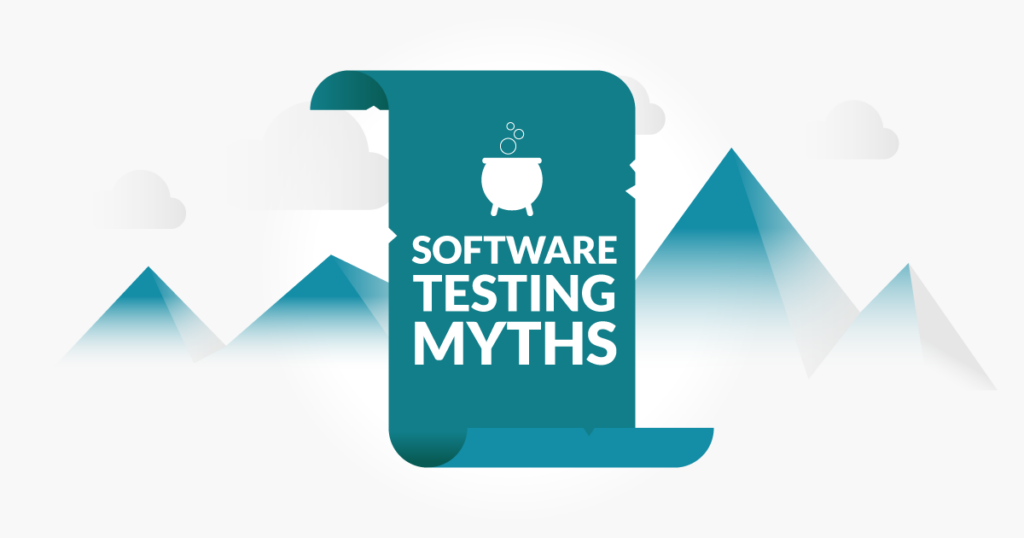There are many software testing myths that, if left unexamined, can negatively influence decisions. Separating software testing myth facts from fiction is essential because if test strategies or resource allocation are designed from misconceptions, software quality will be affected, and individual careers might miss out on opportunities. Let’s discuss and debunk eight of software testing’s most common myths.

1. Software testing is a dying field
We might hear this myth phrased as ‘Automation will take the place of all manual testing’ or ‘AI will make software testing obsolete.’ The truth is that software testing, at its most fundamental basis, will always require a real person to test something.
We live in an age of information technology, and new software applications and programs are created daily. These programs will come with defects, security breaches, and regulation compliance, all of which require human testers.
Situations like these also require testers with expertise in particular areas such as mobile apps, firmware, video games, penetration, and performance. In other words, the more technology is produced, the more software testing is needed, and the future predicts even more new technology to come.
2. There’s no career path in software testing
This myth claims that software testers lack opportunities for career growth. The truth is that software testers with a desire to learn can expand their testing skills into other connected areas. Often, manual testers become automation testers, and automation testers become SDETs. Testers with performance testing experience can expand their knowledge and work in DevOps or cybersecurity. Those with a desire to lead can become quality managers.
Another common career path is moving from tester to developer. A tester with a comprehensive understanding of how a program runs or has learned programming languages when writing test automation can become a back-end developer. Testers possess a particular mindset that allows them to notice imperfections in the User Interface. This aptitude enables them to become excellent front-end developers with a keen eye for details. Testers also become excellent product managers and business analysts because they understand the needs of both the customer and the tech team.
3. Software testers are responsible for product quality
Part of this software testing myth is true. Software testers are responsible for a product’s quality – but they are not solely responsible. Just as keeping data secure is everyone’s responsibility, product quality is the responsibility of all team members involved, but with differing emphases according to their roles. Product managers are responsible for relaying what the client wants in a product and writing high-standard acceptance criteria. Business analysts are responsible for determining efficient processes. Developers are responsible for using best practices when writing code, writing unit tests, and performing code reviews. DevOps is responsible for monitoring deployments and ensuring releases go as expected. Everyone plays a part in delivering a quality product.
4. Automate more to save time in the long run
This myth is probably the most misunderstood. Automation tests should indeed save you time. However, several factors go in to determining whether the return on investment (ROI) is worth the time and effort. Automated test cases are best suited to repetitive and frequently run tests. These tests have to be maintained, which takes up time while trying to save time in execution. If changes are made often, especially to the UI, the automated tests must be regularly updated, which can be time-consuming.
Another consideration is the initial setup and learning curve. Setting up an automation suite takes time, and there are always learning curves when introducing new programs. So, while automation can and should save time, the whole team must understand the related time involved.
5. We wouldn’t need software testers if developers did their job properly
This software testing myth is almost comical and is usually only voiced by those in upper management with no experience in the software development lifecycle. Almost anyone who has spent time with developers and testers will agree that the roles require two very different mindsets. Developers focus on creating solutions for a given task, while the tester’s perspective is on finding flaws in the given solution.
Aside from different mindsets, it’s not best practice to be the only person testing the code you have written. When developers author code, they know it should work according to how they developed it, but unwittingly, there can also be a level of creation bias. Having another person test whether it works as expected will almost always reveal flaws.
Testers may also consider regression testing. Typically, when a developer creates a new feature, they do not run a long list of regression tests to discover if the code breaks something unrelated to the new feature. Testers will look for integrations and complex scenarios that developers typically don’t have time to check.
6. You must learn automation before becoming a software tester
This myth has grown because of the first myth we discussed when we saw how software testing is not a dying field. Now, let’s discuss why becoming a software tester does not require learning automation first. While manual testing has fewer jobs available than before, they are still out there and are a solid option for getting into the software testing field. In fact, exploratory testing, which requires manual testing, is an excellent testing exercise that will almost always produce undiscovered defects.
If someone is interested in learning automation before getting into the testing field, they should keep in mind that companies may require them to write tests in a different programming language. While some knowledge is transferrable, it is advantageous to learn the fundamentals of testing first.
7. The number of reported bugs is a good metric
There has been a recent surge of interest in Key Performance Indicators (KPIs) within the technology field. One commonly seen metric is the number of bugs reported. However, this might not be the most reliable accounting standard. Firstly, what keeps someone from reporting a single defect as multiple bugs? For example, say a company’s name is misspelled on its website. One could easily report the same bug for every page on the website. Although the count will make the tester look great, it takes up more time, with not much else getting done. Instead, why not use the percentage of requirements covered or a defect density rate? These metrics reveal actual performance and show the authentic value of the quality team.
8. Software testing certifications are a waste of time
This software testing myth is often seen on testing forums and is easily debunked. Unequivocally, software testing certifications are an excellent use of time, and educating yourself is never pointless. Even if you never use the certification, the knowledge obtained resides with you forever. Some employers will even pay for you to take a training course or exam, so this situation is a no-brainer.
Second, we all know the job market is competitive. Getting a certification shows employers you have taken the time to apply yourself and that you understand testing fundamentals. It’s easy to share certifications on social media sites, which helps you stand out in the market, and it can also give customers confidence in your abilities as a tester.
Conclusion
Software testing is a fulfilling career with excellent growth potential, and software testers have opportunities to expand their testing skills or move into other fields. Personal development in the form of certifications and trainings can show employers you are willing to put in the effort to learn. We know that job markets will always fluctuate, but software testers will be needed as long as technology is around.
About the writer
Faith Quinn
Faith Quinn is a Lead QA Engineer with more than a decade of QA experience, including PCI and SOX.
All Faith Quinn's articles
